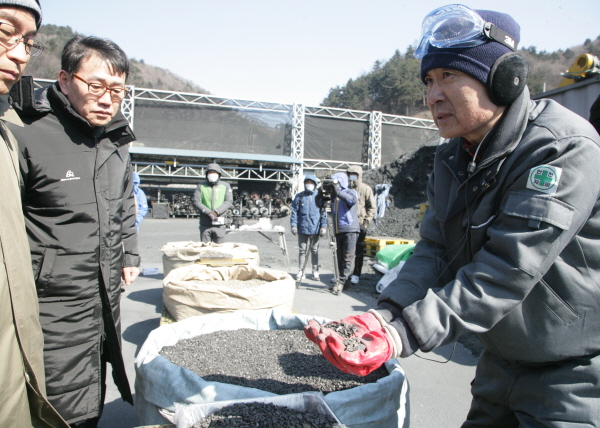- Nameadmin
- Date2015/03/20 00:00
- Hit1,123

- Successfully demonstrated a dry method for preparing low-grade coal (bituminous coal/anthracite/lignite) into high-grade coal
- 50% lower coal preparation cost compared to conventional wet process; commercialization of the new technology is anticipated
On March 11, Korea Institute of Geoscience and Mineral Resources (KIGAM) successfully carried out a demonstration test (10 tons/hour) of the dry coal preparation method that treats low-grade coal (overseas bituminous coal and domestic anthracite) by a dry method in their pilot plant at Kyungdong Sangduk Mine(Dogye-eup, Samcheok, Gangwon-do).
The research team led by Dr. Byoung Gon Kim(Principal Researcher) of KIGAM’s Mineral Resource Research Division has been conducting the research on the development of a dry coal preparation technology for low-grade coal for stable acquisition of coal resources since 2011 under the support of the Ministry of Trade, Industry and Energy. This demonstration was an operation test of the pilot plant that was scaled the capacity up to 10 tons/hour or higher to prepare for the commercialization of the developed technology.
The dry coal preparation technology demonstrated by KIGAM is an economically enhanced technology that can reduce the transportation cost per calorie while increasing the unit calorie by removing impurities from the low-grade coal in dry conditions without water.
Low-grade coal refers to coal with low unit calorie because it contains many impurities such as ash minerals and clay. Low-grade coal accounts for about half of global coal reserves but they have not been developed or utilized actively due to low calorie and economic efficiency. The greatest problem in utilizing low-grade coal is high transportation cost per unit calorie and large volume of wastes (coal ashes) after use. For example, if high-grade coal requires the transportation cost for 1 kg to transport 5,000 Kcal, low-grade coal requires the transportation cost for 2 kg. Furthermore, after use, the former generates 0.2 kg of coal ashes whereas the latter generates 0.5 kg. Therefore, we can greatly enhance the economic value of low-grade coal if we can increase the unit calorie and reduce the transportation cost.
Furthermore, as the dry coal preparation technology does not use water, it has less environmental problems such as wastewater treatment and is essential for coal mines in Mongol and other places where it is difficult to use water. This method is highly economical because the cost for plant installation and operating is about 50% of the conventional wet processes using water.
The plant used for this field demonstration was a dry coal preparation system based on ‘KAT-Table’ developed by the lead of Dr. Byoung Gon Kim from KIGAM. It separates light particles which consisted of pure coal from the heavy gangue particles that contain many mineral impurities by their difference of specific gravity without water.
The KAT-Table dry coal preparation technology (developed and patented by KIGAM) was developed to separate low-grade coal by using the difference in specific gravity of coal and gangue in mines. As coal preparation is possible at mines, the transportation cost to the coal preparation site can be saved, and the gangue removed from the coal preparation can be used to reclaim the mines, thus contributing to the prevention of environmental pollution caused by mining.
The checkpoints were to verify whether the developed system can run continuously at 10 tons/hour or higher capacity and whether it can process even coal particles of 10 mm or smaller which is known as the limit of the commercial dry coal preparation technologies around the world (existing dry coal preparation technologies had the limitation that they are efficient for larger than 20mm coal particles).
In the actual demonstration, the system continuously processed 10 mm or smaller low-grade bituminous coal from Mongol (52% ashes, calorie about 3,500kcal/kg) at 10 tons/hour, achieving 85% of combustible matter recovery and 86% of ash removal rate. It successfully produced high-grade coal with the ash content of 14.6% and the calorie of 6,900kcal/kg.
Furthermore, the system could sort out domestic low-grade anthracites (ashes 53%, calorie about 3,200kcal/kg, no value due to low calorie) at 67% combustible matter recovery and 80% ash removal rate, preparing them into thermal coal resources with the ash content of 25.6% and the calorie of 5,500kcal/kg.
In particular, at this demonstration and technical briefing, KIGAM and the Mine Reclamation Corporation jointly held a meeting for domestic and international coal industry end-user partnership networking session in which more than 20 government officials from major coal-producing Asian countries such as Indonesia, India, Malaysia, Myanmar, and Vietnam as well as people from domestic and international coal industries participated.
In order to complete this high efficient dry coal preparation technology as a competitive technology in the global market and utilize the cheap low-grade coal (bituminous coal/lignite) in energy crises, we need to achieve technology commercialization for at least 50 tons/hour per unit system.